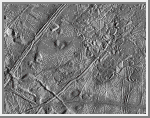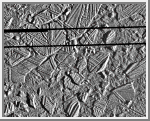













|
| New Images Hint at Wet and Wild History For Europa |
|---|
Chunky ice rafts and relatively smooth, crater-free patches on the surface of Jupiter's frozen moon Europa suggest a younger, thinner icy surface than previously believed, according to new images from Galileo's spacecraft released today.

|

|
|---|---|
| Additional New Galileo Images of Europa | |
The images were captured during Galileo's closest flyby of Europa on Feb. 20, 1997, when the spacecraft came within 363 miles of the Jovian moon. These features, which lend credence to the idea of hidden, subsurface oceans, also are stirring up controversy among scientists who disagree about the age of Europa's surface.
Dr. Ronald Greeley, an Arizona State University geologist and Galileo imaging team member, said the ice rafts reveal that Europa had, and may still have, a very thin ice crust covering either liquid water or slush.
"We're intrigued by these blocks of ice, similar to those seen on Earth's polar seas during springtime thaws," Dr. Greeley said. "The size and geometry of these features lead us to believe there was a thin icy layer covering water or slushy ice, and that some motion caused these crustal plates to break up."
"These rafts appear to be floating and may, in fact, be comparable to icebergs here on Earth," said another Galileo imaging team member, Dr. Michael Carr, a geologist with the U.S. Geological Survey. "The puzzle is what causes the rafts to rotate. The implication is that they are being churned by convection."
The new images of Europa's surface also have sparked a lively debate among scientists. Galileo imaging team member Dr. Clark Chapman is among those who believe the smoother regions with few craters indicate Europa's surface is much younger than previously believed. In essence, Chapman, a planetary scientist at Southwest Research Institute, Boulder, Colorado, believes the fewer the craters, the younger the region. Clark based his estimate on current knowledge about cratering rates, or the rate at which astronomical bodies are bombarded and scarred by hits from comets and asteroids.
"We're probably seeing areas a few million years old or less, which is about as young as we can measure on any planetary surface besides Earth," said Chapman. "Although we can't pinpoint exactly how many impacts occurred in a given period of time, these areas of Europa have so few craters that we have to think of its surface as young."
Chapman added, "Europa's extraordinary surface geology indicates an extreme youthfulness -- a very alive world in a state of flux."
However, Carr sees things differently. He puts Europa's surface age at closer to one billion years old.
"There are just too many unknowns," Carr said. "Europa's relatively smooth regions are most likely caused by a different cratering rate for Jupiter and Earth. For example, we believe that both Earth's moon and the Jovian moon, Ganymede, have huge craters that are 3.8 billion years old. But when we compare the number of smaller craters superimposed on these large ones, Ganymede has far fewer than Earth's moon. This means the cratering rate at Jupiter is less than the cratering rate in the Earth-moon system."
Scientists hope to find answers to some of the questions surrounding Europa and its possible oceans as the Galileo spacecraft continues its journey through the Jovian system.
"We want to look for evidence of current activity on Europa, possibly some erupting geysers," Greeley said. "We also want to know whether Europa's surface has changed since the Voyager spacecraft flyby in 1979, or even during the time of the Galileo flybys."
The craft will return for another Europa flyby on Nov. 6, 1997, the final encounter of Galileo's primary mission. However, eight more Europa flybys are planned as part of Galileo's two-year extended mission, which also will include encounters with two other Jovian moons, Callisto and Io.
The Jet Propulsion Laboratory manages the Galileo mission for NASA's Office of Space Science, Washington, DC.
Images and other data received from Galileo are posted on the Galileo mission home page on the World Wide Web at URL:
Donald Savage Headquarters, Washington, DC April 9, 1997 (Phone: 202/358-1547) Jane Platt Jet Propulsion Laboratory, Pasadena, CA (Phone: 818/354-5011) RELEASE: 97-66
Views of the Solar System Copyright © 1997-2000 by Calvin J. Hamilton. All rights reserved. Privacy Statement.